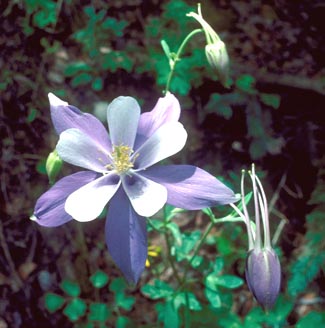Colorado Columbine

Common Name(s):
Colorado Columbine
Colorado Blue Columbine
Rocky Mountain Columbine
Blue Columbine
Scientific Name:
Aquilegia coerulea James
Scientific Name Synonyms:
Aquilegia caerulea James
Symbol:
AQCO
Description:
Life Span: Perennial
Origin: Native
Growth Characteristics: Colorado Columbine is a bushy, clump-forming perennial, 1-2 feet tall and 1-2 feet wide, growing from a taproot. It blooms April-July. Most species are short-lived, living only two or three years.
Flowers: Erect. Columbine is often bi-colored, meaning the sepals and the petals are two different colors. There are 5 petals and 5 sepals. The sepals extend out at right angles from the flower. The petals extend backward forming a slender spur with a bulbous, glandular tip. The petals and sepals range in color from white to blue, or sometimes pink. The stamens are 13-24 mm long, and often extend out beyond the petals. Columbine is pollinated by bees.
Fruits/Seeds: A follicle.
Leaves: The basal leaves are one to three times ternately compound, 9-37 cm, and much shorter than the stems. Leaflets are green on top. The leaves of Columbine are similar to the leaves of Meadow-rue.
Ecological Adaptions:
Colorado columbine occurs throughout the Rocky Mountains at elevations from 6000 to 10,000 feet. Found in sagebrush, pinyon-juniper, mountain-brush, aspen, Douglas fir, Aspen-tall forb, spruce-fir, and alpine tundra communities. It is especially common in Aspen stands.
Soils: Tolerates a wide range of soils except heavy, poorly drained ones. It prefers rich, moist soils with light to moderate shade.
Uses and Management:
Colorado columbine is the state flower of Colorado. All parts of plant are poisonous if ingested.
The seed was chewed, or an infusion of the root was used, to treat abdominal pains and general sickness by Native Americans. The seed was also used as a parasiticide to rid the hair of lice. It is antispasmodic, diaphoretic, parasiticide, and resolvent.

